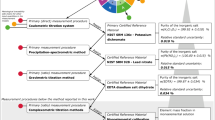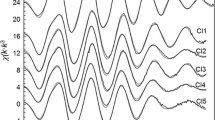Abstract
The molar heat capacity and the standard (p 0 = 0.1 MPa) molar enthalpies of formation of the crystalline of bis(glycinate)lead(II), Pb(gly)2; bis(dl-alaninate)lead(II), Pb(dl-ala)2; bis(dl-valinate)lead(II), Pb(dl-val)2; bis(dl-valinate)cadmium(II), Cd(dl-val)2 and bis(dl-valinate)zinc(II), Zn(dl-val)2, were determined, at T = 298.15 K, by differential scanning calorimetry, and high precision solution-reaction calorimetry, respectively. The standard molar enthalpies of formation of the complexes in the gaseous state, the mean molar metal–ligand dissociation enthalpies, M(II)–amino acid, \( \langle D_{\text{m}} \rangle \)(M–L), were derived and compared with analogous copper(II)–ligand and nickel(II)–ligand.θθ
M(II)–amino acid | \( \Updelta_{\text{f}} H_{\text{m}}^{\text{o}} \)(cr)/kJ mol−1 |
|---|---|
Bis(glycinate)lead(II), Pb(gly)2 | −998.9 ± 1.9 |
Bis(dl-alaninate)lead(II), Pb(ala)2 | −1048.7 ± 1.8 |
Bis(dl-valinate)lead(II), Pb(val)2 | −1166.3 ± 2.5 |
Bis(dl-valinate)cadmium(II), Cd(val)2 | −1243.7 ± 2.7 |
Bis(dl-valinate)zinc(II), Zn(val)2 | −1306.1 ± 2.3 |



Similar content being viewed by others
References
Vigato PA, Tamburini S. The challenge of cyclic and acyclic Schiff bases and related derivatives. Coord Chem Rev. 2004;248:1717–2128.
Ganguly R, Sreenivasulu B, Vittal JJ. Amino acid containing reduced Schuff bases as the building blocks for metallasupramolecular structures. Coord Chem Rev. 2008;252:1027–50.
Finney LA, O’ Halloran TV. Transition metal speciation in the cell: insights from the chemistry of metal ion receptors. Science. 2003;300:931–6.
Berg BJ, Shi Y. The galvanization of biology: a growing appreciation for the roles of zinc. Science. 1996;271:1081–5.
Frauscher G, Karnaukhova E, Muehl A, Hoeger H, Lubec B. Oral administration of homocysteine leads to increased plasma triglycerides and homocysteic acid—additional mechanisms in homocysteine induced endothelial damage? Life Sci. 1995;57:813–7.
Chohan ZH, Arif M, Sarfraz M. Metal-based antibacterial and antifungal amino acid derived Schiff bases: their synthesis, characterization and in vitro biological activity. Appl Organometal Chem. 2007;21:294–302.
Rauser WE. Structure and function of metal chelators produced by plants. The case of organic acids, amino acids, phytin and metallothioneins. Cell Biochem Biophys. 1999;31:19–48.
Martin RB. Complexes of α-amino acids with chelatable side chain donor atoms. In: Sigel H, editor. Metal ions in biological systems, vol. 9. New York: Marcel; 1979.
Polfer NC, Oomens J, Moore DT, von Helden G, Meijer G, Dunbar RC. Infrared spectroscopy of phenylalanine Ag(I) and Zn(II) complexes in the gas phase. J Am Chem Soc. 2009;128:517–25.
Ashcroft SJ, Mortimer CT. Thermochemistry of transition metal complexes. London: Academic Press; 1970.
Ribeiro da Silva MAV, Ribeiro da Silva MDMC, Bernardo MMC, Santos LMNBF. Thermochemistry of some metallic aminoacid complexes. Part I copper(II) complexes. Thermochim Acta. 1992;205:99–113.
Ribeiro da Silva MAV, Ribeiro da Silva MDMC, Tuna JABA, Santos LMNFS. Thermochemistry of some metallic aminoacid complexes. Part II nickel(II) complexes. Thermochim Acta. 1992;205:115–25.
Flaschka HA. EDTA titrations. London: Pergamon; 1959.
Gunn SR. On the calculation of the correct temperature rise in isoperibol calorimetry. Modifications of the Dickinson extrapolation method and treatment of thermistor thermometer resistance values. J Chem Thermodyn. 1971;3:19–34.
Santos LMNBF. PhD Thesis. University of Porto; 1995.
Irving RJ, Wadsö I. Use of tris(hydroxymethyl)aminomethane as a test substance in reaction calorimetry. Acta Chem Scand. 1964;18:195–201.
Sabbah R, An X, Chickos JS, Planas Leitão ML, Roux MV, Torres LA. Reference materials for calorimetry and differential thermal analysis. Thermochim Acta. 1999;331:93–204.
Wieser ME. Atomic weights of the elements 2005 (IUPAC Technical Report). Pure Appl Chem. 2006;78:2051–66.
Rossini FD. Assignment of uncertainties to thermochemical data. In: Rossini FD, editor. Experimental thermochemistry, vol. 1, chapter 14. New York: Interscience; 1956.
Della Gatta G, Richardson M, Sarge SM, Stølen S. Standards, calibration, and guidelines in microcalorimetry. Part 2. Calibration standards for differential scanning calorimetry (IUPAC Technical Report). Pure Appl Chem. 2006;78:1455–76.
Barros TMVR, Santos RC, Fernandes AC, Piedade MEM. Accuracy and precision of heat capacity measurements using a heat flux differential scanning calorimeter. Thermochim Acta. 1995;269:51–60.
Höhne GWH, Hemminger WF, Flammersheim HJ. Differential scanning calorimetry. 2nd ed. Berlin: Springer-Verlag; 2003.
Steele WV, Chirico RD, Knipmeyer SE, Nguyen A. The thermodynamic properties of thianthrene and phenoxathiin. J Chem Thermodyn. 1993;25:965–92.
Wagman DD, Evans WH, Parker VB, Shum RH, Halow F, Bailey SM, Churney Kl, Nuttall RL. NBS tables of chemical thermodynamic properties. J Phys Chem Ref Data. 1982;11(Suppl 2):1–392.
Ribeiro da Silva MAV, Santos LMNBF. Standard molar enthalpies of formation of Ni(CH3COO)2, Ni(CH3COO)2·4.00H2O, Cd(CH3COO)2, and Cd(CH3COO)2·2.00H2O in the crystalline state. J Chem Thermodyn. 2000;32:1327–34.
Pedley JB. Thermochemical data and structures of organic compounds. Thermodynamics Research Center, College Station: CRC Press; 1994.
de Kruif CG, Voogd J, Offringa JCA. Enthalpies of sublimation and vapour pressures of 14 amino acids and peptides. J Chem Thermodyn. 1979;11:651–6.
Kamaguchi A, Sato T, Sakiyama M, Seki S. Enthalpies of combustion of organic compounds. III. d-, l- and dl-alanines. Bull Chem Soc Jpn. 1975;48:3749–50.
Ribeiro da Silva MAV, Ribeiro da Silva MDMC, Santos LMNBF. Standard molar enthalpies of formation of crystalline l-, d- and dl-valines. J Chem Thermodyn. 2000;32:1037–43.
Cox JD, Wagman DD, Medvedev VA. CODATA key values for thermodynamics. New York: Hemisphere; 1989.
Badelin VG, Kulikov OV, Batagin VS, Udzig E, Zielenkiewicz A, Zielenkiewicz W, et al. Physico-chemical properties of peptides and their solutions. Thermochim Acta. 1990;169:81–93.
Ribeiro da Silva MAV. Energetics of metal–ligand bonds. New J Chem. 1997;21:671–80.
Ribeiro da Silva MAV, Ferrão MLCCH. Energetics of metal–oxygen bonds in metal complexes of ß-diketones. Pure Appl Chem. 1988;60:1225–34.
Ribeiro da Silva MAV. Thermochemistry of β-diketones and metal-β-diketonates. Metal–oxygen bond enthalpies. In: Ribeiro da Silva MAV, editor. Thermochemistry and its applications to chemical and biochemical systems. NATO ASI Series, vol. 119. Dordrecht: D. Reidel Publishing; 1984.
Acknowledgements
Thanks are due to FCT (Fundação para a Ciência e Tecnologia), Lisboa, Portugal and to FEDER for financial support granted to Centro de Investigação em Química da Universidade do Porto.
Author information
Authors and Affiliations
Corresponding author
Rights and permissions
About this article
Cite this article
Ribeiro da Silva, M.A.V., Santos, L.M.N.B.F., Faria, A.C.P. et al. Energetics of lead(II), cadmium(II) and zinc(II) complexes with amino acids. J Therm Anal Calorim 100, 475–482 (2010). https://doi.org/10.1007/s10973-009-0650-y
Received:
Accepted:
Published:
Issue Date:
DOI: https://doi.org/10.1007/s10973-009-0650-y




